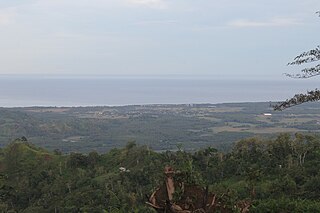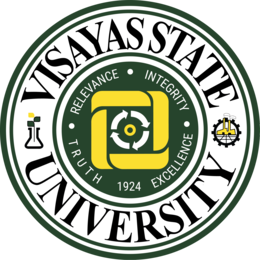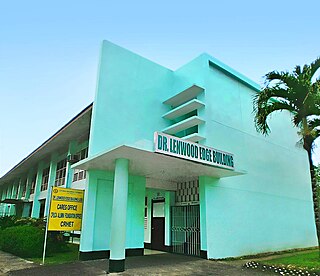The Xavier University – Ateneo de Cagayan, also known simply as the Ateneo de Cagayan or Xavier is a private, Catholic, coeducational, basic and higher education institution. It is operated by the Philippine Province of the Society of Jesus in Cagayan de Oro, Misamis Oriental, Philippines. Founded in 1933 as the Ateneo de Cagayan, it became the first higher education institution in Mindanao to receive a university status a year before its sister school Ateneo de Manila. It was given its present name in honor of the Jesuit missionary St. Francis Xavier.

The Moro Gulf is the largest gulf in the Philippines. It is located off the coast of Mindanao Island, and is part of the Celebes Sea. The gulf is one of the country's tuna fishing grounds.

The Mindanao State University is a state university system in the city of Marawi, Philippines. It is the first state university in Mindanao, Philippines, established through Republic Act 1387. It is the second state-sponsored institution in the country, following the University of the Philippines.
Mindanao Association of State Tertiary Schools, Inc. is an association of public Tertiary level schools in the Mindanao region of the Philippines. It is composed of the following schools:

Philippine Rice Research Institute (PhilRice) is a government corporate entity attached to the Department of Agriculture created through Executive Order 1061 on November 5, 1985 to help develop high-yielding and cost-reducing technologies for farmers.
This is a list of notable media outlets in Zamboanga City, a city in the Zamboanga Peninsula administrative region of the Philippines. Although geographically separated, and an independent and chartered city, Zamboanga City is grouped with the province of Zamboanga del Sur for statistical purposes, yet governed independently from it.

Cebu Institute of Medicine (CIM) is a private medical school located in Cebu City, Philippines. The medical school is affiliated with the Velez College.

The Philippines' Bureau of Fisheries and Aquatic Resources, is an agency of the Philippine government under the Department of Agriculture responsible for the development, improvement, law enforcement, management and conservation of the Philippines' fisheries and aquatic resources.

The Philippine Normal University is a public coeducational teacher education and research university in the Philippines. It was established in 1901 through Act No. 74 of the Philippine Commission "for the education of natives of the Islands in the science of teaching". It has campuses in Manila, North Luzon, South Luzon, Visayas, and Mindanao. Pursuant to Republic Act No. 9647, it is the country's National Center for Teacher Education.

Science and technology in the Philippines describes scientific and technological progress made by the Philippines and analyses related policy issues. The main agency responsible for managing science and technology (S&T) is the Department of Science and Technology (DOST). There are also sectoral councils for Forestry, Agriculture and Aquaculture, the Metal Industry, Nuclear Research, Food and Nutrition, Health, Meteorology, Volcanology and Seismology.

The University of the Philippines Visayas is a public research university in Iloilo, Philippines. A constituent university of the University of the Philippines system, it teaches management, accountancy, marketing, economics, chemistry, applied mathematics and physics, marine science education and research, fisheries, and aquaculture. It offers regional studies programs on the preservation and enrichment of the Visayan cultural heritage.

The Philippine Carabao Center an attached agency of the Department of Agriculture, was established at Science City of Muñoz in Nueva Ecija province in 1992 to breed and cross carabao based on high-yield Murrah buffalo in the Philippines as a multi-purpose animal that can be raised for milk, meat, hide, and draft.

The University of Eastern Philippines is the first state university in the Visayas. It offers the largest number of undergraduate and graduate degree programs and short-term courses and certificates among the higher education institutions in the Eastern Visayas region. Its flagship campus is in Catarman, Northern Samar.

Visayas State University is a university located in the city of Baybay, province of Leyte, Philippines. The five-campus VSU has eight colleges, three institutes and one school. Located in the main campus are the College of Veterinary Medicine, College of Engineering and Technology, College of Education, College of Forestry and Environmental Science, College of Arts and Science, College of Nursing, College of Management and Economics, College of Agriculture and Food Sciences, Institute of Strategic Research and Development Studies, Institute of Tropical Ecology and Environmental Management, Institute of Human Kinetics, and the Graduate School and Special Programs.

The UPLB Limnological Research Station traces its root from the Department of Entomology, of the then UP College of Agriculture. Since its conception, the station contributed immensely to the understanding of the bounties of Laguna de Bay and helped establish the duck farming industry on Los Baňos foreshores and pioneered in aquarium fish production in the country. It serves as the base for studies on limnology and biology of aquatic organisms aimed at developing strategies for the optimum utilization and sustained production of aquatic resources; developing, adapting or improving conventional technologies used to increase fish production; and promoting environment friendly approaches for effective water management.

The University of Southern Mindanao, formerly Mindanao Institute of Technology (MIT), is a university in the Southern Philippines. It provides instruction and professional training in the fields of science and technology, particularly agriculture and industry. The university was founded by Bai Hadja Fatima Matabay Plang, an educator and philanthropist. It formally open on October 1, 1954, and achieved university status on March 13, 1978. Its 1,024 hectare main campus is located in Kabacan, Cotabato. The University of Southern Mindanao is one of the four State University and Colleges (SUC) to achieve excellence in agricultural education and one of the nine to hold Level IV status. Across its 3 campuses USM holds a total of 5,129.97 hectares of land, mostly for agricultural teaching and research.

The Davao del Norte State College is a public college in New Visayas, Panabo City, Philippines which provides instruction and progressive leadership in education, engineering, arts, sciences, fisheries, and other fields.

The Central Philippine University College of Agriculture, Resources and Environmental Sciences, also referred to as CPU CARES or CPU Agriculture, is one of the academic units of Central Philippine University, a private university in Iloilo City, Philippines.

Mudjekeewis Dalisay Santos is a Filipino fisheries scientist and marine biologist at the National Fisheries Research and Development Institute (NFRDI). He was the first Career Scientist to have been conferred the Scientist V rank by the Scientific Career System. In July 2018, he was elected and conferred as an academician member of the National Academy of Science and Technology of the Philippines (NAST-PHL). He is also the president of the Philippine Society in Biochemistry and Molecular Biology since 2022. His fields of interest in fisheries science are genetics, resource assessment, aquatic biodiversity, biotechnology, climate change adaptation, and policy.



















